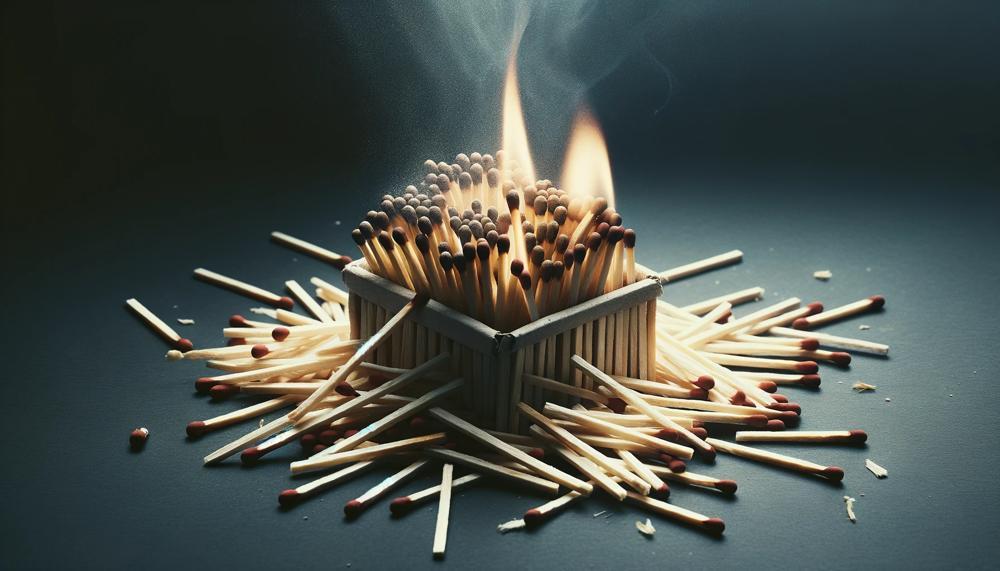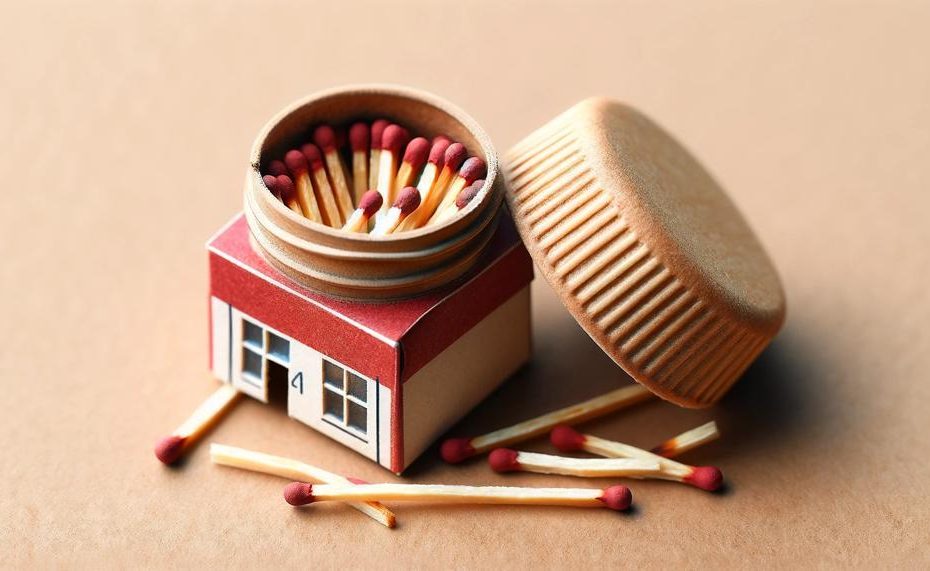Have you ever struck a match, watched it burn down, and then wondered, “Now what?” The seemingly simple act of disposing of a used match can often be overlooked, yet it hides a spark of danger if not done correctly. Playing with fire, quite literally, requires a level of respect and caution—even after the flame is out.
So, how to dispose of matches safely?
You can safely dispose of used matches by soaking them in water for five minutes to an hour, then throwing them away in the trash. You can also use them in your fireplace or fire pit.
You should never dispose of unused matches in any waste container or down the drain, including the sink and/or toilet. Unused matches can spark fires when striking another surface, creating an unsafe environment for waste workers.
You can compost wooden matches because of the phosphorus found on match heads, which is a naturally occurring chemical that’s safe to add to garden soil and mulch.
By sticking to these pointers, you can keep the simple act of disposing of a match from turning into something more heated.
So, let’s light up this discussion with some safe practices that will keep both the warmth and peace of mind in your cozy corner of the world.
Contents
What Are Matches?
Matches are ingeniously simple devices, designed to produce a flame through a chemical reaction.
Below is a table detailing the common materials used in match production and their specific roles:
| Component | Material | Function |
| Match Head | Phosphorous sulfide, potassium chlorate, paraffin wax | Ignition source providing flammability and sustaining the flame |
| Match Handle | Poplar, pine, or aspen wood | Supporting structure, fuel for the flame |
| Flame Retardant Soak | Various chemicals | Prevents the wood from combusting too quickly |
The head of the match contains a blend of flammable chemicals that, when struck against a suitable friction surface, undergo a chemical reaction to produce fire. Phosphorous sulfide ignites from the friction, while potassium chlorate helps sustain the reaction, providing oxygen to fuel the flame. Paraffin wax aids in the spread of the flame to the matchstick.
The matchstick itself, traditionally crafted from softwoods like poplar, pine, or aspen, serves as a handle while also acting as additional fuel once the flame takes hold. These woods are chosen for their ability to burn steadily and evenly.
Before being used, these matchsticks are often soaked in a flame retardant solution. This process ensures that the match doesn’t burn too quickly or uncontrollably, providing a measure of safety to the user.
In terms of safe disposal, it’s crucial to douse matches with water after use. This routine extinguishes any remaining embers and prevents any unintended fires. Unused matches, similarly, should be water-soaked to nullify their ignition potential before being thrown away. Weatherproof matches, due to their tenacity and cost, are best burned off completely.
Can You Throw Away Unused Matches?
Sure as sunshine, you can chuck unused matches in the bin. But hold your horses, there’s a proper way to do it, safe and sound.
Soak ’em in water first to stop any chance of a fire starting on the sly. Matches are a bit like a sleeping dragon; harmless if left alone, but can breathe fire if riled up wrong.
Preventing a Blaze Before it Begins:
- Dunk those matches in water, and make sure they’re drenched through and through.
- Let ’em sit a spell until you’re certain they’ve given up the ghost and can’t light no more.
Disposal Dos and Don’ts:
- Once they’re wetter than a drowned rat, you can toss ’em straight into the trash.
- If those matches have done their duty and are spent, no need for a swim; just throw ’em out.
Eco-Friendly Tips:
- Unused matchboxes, strip them of their fiery stripes, and they’re good for recycling.
- Got a pile of unused matches? Burning them in a safe spot is another way to clear them out.
Disposing of Unused Matches Properly
To ensure a safe farewell to those unlit matches, let’s have a gander at some proper methods that keep troubles at bay and are gentle on Mother Nature.
| Method | Details | Why It’s Safe |
| Water Soaking | Submerge matches in water. | Prevents ignition by removing flammable properties. |
| Cooling Off | Allow used matches to cool before disposal. | Ensures no residual heat can cause a fire. |
| Disposal in Batches | Throw away small quantities at a time. | Reduces fire risk by limiting potential fuel sources. |
| Controlled Burning | Burn in a fireplace or fire pit. | Utilises a safe environment to eliminate matches as a hazard. |
| Recycling Matchboxes | Recycle the box, remove the ignition strip. | Keeps recyclable material in use and out of landfills. |
Remember, it’s not just about chucking them out; it’s about doing it with a dollop of sense and a nod to the planet.
Submerging Unused Matches in Water
To properly dispose of unused matches by submerging them in water, follow these straightforward steps:
| Step | Action | Purpose |
| 1 | Fill a container with water | To prepare a soaking medium for the matches |
| 2 | Soak matches | To saturate and nullify the flammable compounds |
| 3 | Discard soaked matches | To safely dispose of the now non-flammable items |
| 4 | Repeat in batches if necessary | For handling a large quantity of matches |
Remember, matches should not be disposed of while they are still dry, as they could ignite and cause a fire. Soaking them in water is a swift and effective method to prevent such hazards.
Also, consider removing the ignition strip from matchboxes before recycling them, as these strips should not be discarded with the paper or cardboard due to their chemical coating.
Recycling Matchboxes and Wooden Sticks
Matchboxes and wooden sticks, despite their diminutive size, harbour chemicals that could kick-up a fuss if not binned with care. Here’s the skinny on how to ditch ’em without sparking trouble:
Snuff ’em Out:
Before you even think about chucking matches, make sure they’re extinguished. A doused match is a safe match.
Break and Contain:
Snap the matches in half – they lose their zing. Stow them in a container with a lid that fits like a glove to keep them from getting frisky.
Composting:
Unused matchsticks can cosy up in your compost pile. They’re wood, after all, and they’ll break down just peachy.
Arts and Crafts:
If you’ve got an artsy streak, matchsticks can morph into mini masterpieces. Get creative and give ’em a second life.
Phosphorus Matches:
Those matches that feel a bit more high-maintenance, with phosphorus, should be taken to a hazardous waste shindig.
Avoid Water Submersion:
Dunking matches in H2O isn’t the bee’s knees. It’s not safe nor eco-friendly, as they could still light up and do some damage.
Repurpose the Boxes:
Matchboxes are nifty little containers waiting for a new gig. Use ’em to corral your bits and bobs or spruce ’em up for storage with flair.

Local Recycling Programs:
Your neighbourhood waste management might have the lowdown on recycling these fiery little sticks. Give ’em a bell and find out.
Safe Disposal Guide
Check out this table for a quick rundown on how to handle match disposal like a pro:
| Item | Action | Reason |
| Matchsticks (used) | Break in half, store in a sealed container | Prevents accidental ignition |
| Matchsticks (unused) | Add to compost or use in crafts | Repurposing and biodegrading |
| Phosphorus matches | Take to hazardous waste facility | Contains harmful chemicals |
| Submersion in water | Avoid this method | Not safe or environmentally sound |
| Matchboxes | Repurpose for storage or crafts | Reduces waste and encourages creativity |
When you’re done with the fiery bits, remember to give ’em a proper send-off. It’s a small gesture, but it speaks volumes for Mother Earth’s wellbeing.
Conclusion
In conclusion, the safe disposal of matches is not just a mundane afterthought but an essential safety practice that ensures the cozy glow of a flame doesn’t kindle an unwanted blaze.
Always ensure matches are completely extinguished and give them a quick dip in water for certainty’s peace of mind. Dispose of them in a non-flammable container to keep risks at bay.
For unused matches, a water soak renders them harmless, effectively snuffing out their potential for ignition before they join other waste. Recycling matchboxes is a great way to be eco-conscious, just strip them of their ignition strip first.
Practicing these simple steps can keep the act of lighting a match from sparking into something more serious, allowing us to enjoy the comfort and utility of fire without the worry.





